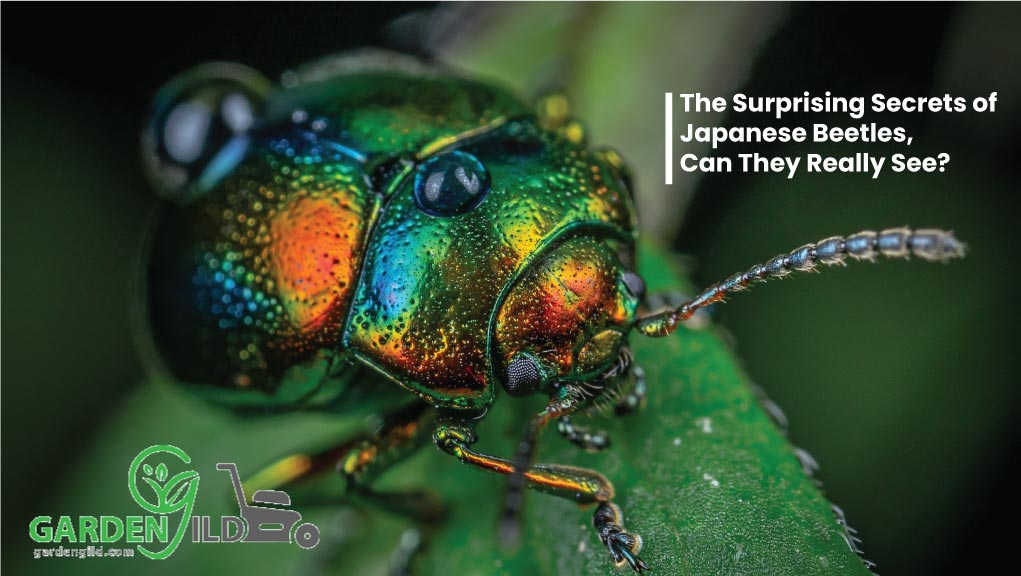No, Japanese beetles are not blind.
Japanese beetle belongs to the beetle family that has two compound eyes. As the Japanese beetle is commonly known as a pest, it is a prerequisite for gardeners or noob environmentalists to know its biology.

In this article, we will talk about the eyes of Japanese beetles and how they see through these eyes.
Do Japanese Beetles Have Eyes?
Yes, the Japanese beetle has compound eyes. The single active unit of this eye is called Ommatidia. Ommatidia is the functional unit of a beetle eye. More than a thousand Ommatidia build a single eye of the Japanese beetle.
How Does Ommatidia Work?
To know the function of Japanese beetle eyes, we need to understand Ommatidia’s molecular structure and function. As per ophthalmologic terms, Ommatidia is referred to as compound eyes. It presents multiple images, not one.
For a single vision, the pest will see different versions of it. And most importantly, that will be based on color contrast. When an object moves, Ommatidia shuts on or off in response. That signals the beetle brain that there is a moving object in front. That effect is called as Flicker effect.
The Flicker effect is detected by the beetle brain Ganglia, and in response, the beetle decides what to do next!
Let the beetle decide about the moving object, and now we should focus on our prime question.
Are Japanese beetle Really Blind?

No, the Japanese beetle is not blind. As we have already mentioned, they have a pair of compound eyes, and the vision is 360°. It can detect light patterns and black dots. But, compared to humans or other developed organisms, they don’t have a clearer vision of objects.
Another interesting fact is that the Japanese beetle’s two eyes are different in size. The two eyes have two different types of functions. One of the eyes is called the Dorsal eye, and the other is called the Ventral eye. We will not go into a deep biological explanation, but simply, the Dorsal eye provides clearer vision than the ventral eye.
The dorsal eye of the Japanese beetle is responsible for the primary vision and localization of objects. In contrast, the ventral eye communicates with Ganglia through nerves and presents images to the insect brain.
Mainly, Japanese beetle depends on their antenna and eyes to perform movements. Without one of these vital organelles, it could fail to make correct movement decisions or even collect food.
What is the shape and location of Japanese Beetle eyes?
We now know that Japanese beetle have eyes and are not blind. Let’s explore where the eyes are located and what are the shapes of the eyes.
Remember, earlier; we talked about antennae?
Yes, there are two antennae on the head of the Japanese beetle. The eyes are located just behind the two antennas. The shape of the eyes is the spindle.
Anatomy of the Japanese beetle:
At the front of the Japanese beetle is an oval-round-shaped organ called the vertex. For simplicity, we can refer to the vertex as beetle head. The head vertex consists of there different organs. These are frons, antennae and eyes. These three are significant organs that establish communication with the outer world. These organs are highly responsible for sight, movement and food.
Next to the vertex is pronotum. It mainly serves as a shield for the beetle. There are three different types of legs with varying functions. There are a total of six legs. The first pair of legs are called the foreleg, which is mainly responsible for movement and direction change.
The next pair of legs are called the midleg, which is responsible for balance and food collection. And the posterior legs are called hindlegs.
The abdomen of the beetle is located very near to the hindleg.
How do Japanese beetles find food?
You might be curious about which organ of the Japanese beetle plays a vital role in detecting food. Biologists say it’s mostly the antenna in slight combination with the eyes.
Mainly, the antenna detects smell and chemicals from the environment through the receptors. There are many receptors on the beetle’s antenna. These thread-like objects receive chemicals from the nodes and send corresponding signals to the ganglia. That’s the way Japanese beetles sense or smell food.
What is the color of Japanese Beetle eye?
An interesting fact is that most beetles’ eyes have strong metallic color. But the Japanese beetle is slightly different. The eye color of the Japanese beetle is dark black. This is because the vertex (frontal head) is light back in color, so the eyes are black.
This type of color combination keeps Japanese beetles safe from their predators.
Can Beetle eye detect colors?
Japanese beetle can’t see or distinguish between different colors. What they really see is color contrast. Based on different contrast, they sense different types of colors.
Color contrast doesn’t matter for the beetle to thrive or survive. Mostly, they rely on noses.
Final Takes: Japanese beetle has a pair of compound eyes. It is not blind, but the vision is not clear. Mainly, it sees things by the difference of color contrasts.

